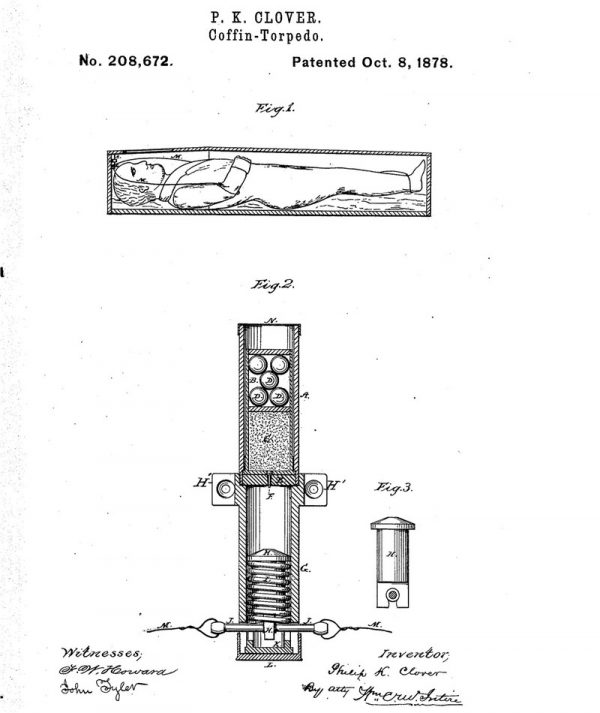Why (and How) a Dead Man Committed a Murder
Murders happen all too often — every day, probably. It’s something we generally don’t want to happen in our society, so we have laws and punishments for those who commit them. So when some guy named Dipper was murdered on January 17, 1881, society should have been demanding justice, taking action against the person who took Dipper’s life. But there was a problem: the murderer was already dead.
Kind of.
Wait. Not “kind of dead” — the “already dead” part is clear. The “murderer” part is the part that needs explaining.
Dipper, to be clear, was both victim and malfeasor in the story of his death. As Atlas Obscura recounts, Dipper was up to no good on the night of the 17th: he and two co-conspirators were out to rob some graves. Unfortunately for Dipper, John Scott Harrison had died three years earlier. Harrison wasn’t in the grave Dipper and his friends were robbing, but he was famous; as the son of former U.S. President William Henry Harrison (and a congressman from Ohio himself), John Scott Harrison’s whereabouts were a matter of both local and national interest. And when Harrison died in 1878, his whereabouts should have been rather easy to determine: he was, like most dead people, supposed to be in his grave.
But that wasn’t the case, as WOSU reported:
Kevin Grace, an archivist at the University of Cincinnati, says when mourners arrived at Harrison’s tomb, they saw a nearby grave had been disturbed.
“The next day they were searching for this other body they had thought had been stolen nearby Harrison’s grave, and the trail took them to the Ohio Medical School,” Grace says.
A janitor at the school let them in, and Harrison’s son noticed a rope hanging down in a shaft. He pulled it up, and at its end was Harrison.
That a corpse had been stolen from its grave and brought to a medical school wasn’t that unusual; as the above-linked Atlas Oscura article points out, “as medical schools proliferated after the Civil War, the field grew increasingly tied to the study of anatomy and practice of dissection. Professors needed bodies for young doctors to carve into and the pool of legally available corpses—executed criminals and body donors—was minuscule.” The teachers of would-be doctors needed bodies, and there were lots of them sitting six feet under; all you needed was to find someone willing to dig one up for you (for a fee, of course). The fact that doing so was both illegal and reprehensible (not to mention, gross) just made the work more lucrative. Grave robbing was easy, profitable, and not all that dangerous — sure, you might get arrested, but at least the victim isn’t going to hit you back.
But the Harrison corpse theft changed that. Him being famous meant no one’s body was safe from this scandalous behavior. The news of his body’s fate quickly spread, and so did the outrage among those who did not want to see their loved ones’ final resting places disturbed. The law wasn’t doing enough to protect them, so the survivors took matters into their own hands. The solution: the corpse torpedo.
Here’s a picture from the patent application.

That doesn’t really tell you much about how it works, but really, it was quite simple; as 99 Percent Invisible summarizes, “initial versions [ . . . ] were essentially small shotguns aimed upward and triggered by the opening of a lid,” while later versions “includ[ed] explosives, which relied less on precise positioning and aim.” More high-tech ones came a few years later; Atlas Obscura makes notes that “a former Circleville probate judge Thomas N. Howell, patented a grave torpedo of his own on December 20, 1881. Unlike the [1878] torpedo, Howell’s gadget was a shell buried above the coffin and wired to it. This worked like a landmine and would detonate when thieves ran into the wiring.” (Howell advertised his invention in poem: “Sleep well sweet angel, let no fears of ghouls disturb thy rest, for above thy shrouded form lies a torpedo, ready to make minced meat of anyone who attempts to convey you to the pickling vat.”)
Dipper — who died during a grave robbing expedition in January of 1881 — probably wasn’t done in by the landmine-style torpedo, but he met his end in a similar fashion. It’s unclear (but unlikely) if anyone was charged with his murder.
Bonus fact: A better use for a grave? Dessert! Two squares of chocolate, two teaspoons of butter. Melt over low heat. Then stir in a cup of milk and bring it to a boil. Add three cups of sugar and a teaspoon of vanilla — and a pinch of salt. Cook it to “softball” stage — I’m not really sure what that means — and then pour it onto a marble slab. Let it cool and beat (I really don’t know what that means) and then eat!
That, according to the grave of Dr. Wade Andrews, is his wife’s fudge recipe. He loved it so much that he wanted it engraved on his tombstone. And when he died in 2000, that’s exactly what his family did. (You can see a picture of the grave at the link, but alas, no picture of the fudge.)
From the Archives: Mortsafes: A much less violent way to protect your loved one’s body.
